The following article originally appeared on the now-defunct GridFe website but never found its way to Football Perspective after Adam Steele and I decided to shut things down in our little corner of the internet. For the sake of having a reference, I have decided to republish in Chase’s space. Below is the article as originally published following the 2018 season.
The GridFe Hall of Fame 2019 class features no quarterbacks and is heavy on running backs, tight ends, and linemen. [1]The only quarterback who received votes got just two of them. Meanwhile, several linemen just missed the cut. Unlike the defensive hall of fame class, the offense features no active players. In fact, the most recent player last played in 1988. Perhaps that’s indicative of more clearly worthy defensive players in today’s league, or maybe it simply means more voters have taken a wait-and-see approach with regards to positions that have seen significant stat inflation in recent years. [2]An alternative theory is that we voted for all the worthy offensive players in the inaugural class. Tom Brady, Drew Brees, Aaron Rodgers, Adrian Peterson, Larry Fitzgerald, Jason Witten, and Antonio … Continue reading It’s outlandish to believe that with greater talent than ever before, only one hall of fame caliber wide receiver has entered the league in the last twenty years. Is it possible we have exercised too much caution with modern players? I don’t know, but it’s certainly possible. Below are eight inductees for this year’s class. Read and determine for yourself. [3]Others receiving votes: Len Dawson, Curtis Martin, Ollie Matson*, Bobby Mitchell*, Elroy Hirsch, Pete Pihos*, Rayfield Wright*, Jim Tyrer*, Gary Zimmerman*, Joe DeLamielleure*
GridFe Hall of Fame Offense
Marion Motley (1946-1955)
Cleveland Browns, Pittsburgh Steelers
5 First Team All Pros (4 AAFC/1 NFL), 1 Pro Bowl, 6 Title Wins, 3 Title Losses, 1 GridFe World Award (AAFC), 1 GridFe Sweetness Award, 1 GridFe Supersonic Award, 7 GridFe Motley Awards (4 AAFC/3 NFL) [4]The Pro Bowl didn’t exist when Motley played in the AAFC, but he was worthy of the honor all four years.
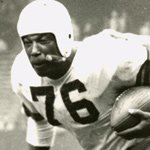 On a team steeped in championship glory, full of legends, Motley stood out on film as the best player on any field. He was simply bigger, stronger, and faster than everyone else. A crushing run blocker and a devastating pass protector who Weeb Ewbank once opined “takes the romance out of the blitz,” Motley is the finest blocking back in the long history of professional football. At 6’1″ and over 230 pounds, Motley is rightly remembered as a bruiser. However, sometimes overlooked is his athleticism and ability to break big plays. He held the record for single game rushing average (17.1) for 52 years and still holds the career record (5.7). [5]He carried the ball 11 times for 188 yards in a blowout victory over the Steelers in 1950. He lost the record in 2002 when Michael Vick ran 10 times for 173 yards in an electrifying performance … Continue reading He was even better in the postseason, boasting 7.1 yards per carry over nine games. [6]In his nine seasons, he carried the ball 908 times. That isn’t the type of workload you’d expect from a player of his caliber, but much of this is because Paul Brown reportedly tried to … Continue reading While Motley didn’t catch many passes (85), he did post an impressive 13 yard average. He spent time at linebacker and played defensive line in goal line situations was said to be a natural talent at both. It’s no wonder Dr. Z (who saw an awful lot of players) called Motley the greatest player he ever saw.
On a team steeped in championship glory, full of legends, Motley stood out on film as the best player on any field. He was simply bigger, stronger, and faster than everyone else. A crushing run blocker and a devastating pass protector who Weeb Ewbank once opined “takes the romance out of the blitz,” Motley is the finest blocking back in the long history of professional football. At 6’1″ and over 230 pounds, Motley is rightly remembered as a bruiser. However, sometimes overlooked is his athleticism and ability to break big plays. He held the record for single game rushing average (17.1) for 52 years and still holds the career record (5.7). [5]He carried the ball 11 times for 188 yards in a blowout victory over the Steelers in 1950. He lost the record in 2002 when Michael Vick ran 10 times for 173 yards in an electrifying performance … Continue reading He was even better in the postseason, boasting 7.1 yards per carry over nine games. [6]In his nine seasons, he carried the ball 908 times. That isn’t the type of workload you’d expect from a player of his caliber, but much of this is because Paul Brown reportedly tried to … Continue reading While Motley didn’t catch many passes (85), he did post an impressive 13 yard average. He spent time at linebacker and played defensive line in goal line situations was said to be a natural talent at both. It’s no wonder Dr. Z (who saw an awful lot of players) called Motley the greatest player he ever saw.
Joe Perry (1948-1963)
San Francisco 49ers, Baltimore Colts
1 MVP, 4 First Team All Pros (1 AAFC/3 NFL), 3 Pro Bowls, 1 Title Loss (AAFC), 1 GridFe Sweetness Award, 3 GridFe Supersonic Awards (1 AAFC/2 NFL) [7]Like Motley, Perry was worthy of Pro Bowl honors during his time in the AAFC.
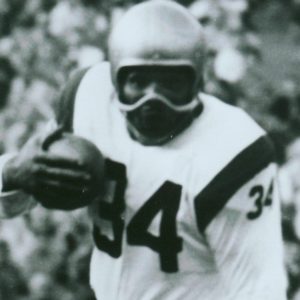 The Jet’s numbers don’t stand out from a modern perspective, and he is often unfairly labeled a compiler. To call him a compiler is to admit a lack of understanding of both Perry’s career and the era in which it occurred. He played in a committee era, when workhorse backs weren’t common. Sharing the backfield with legendary runners Hugh McElhenny and John Henry Johnson, Perry stood out as the clear leader of the pack. Blessed with incredible acceleration, Perry was able to go from a standstill to full speed before defenders could adequately react. That burst, combined with his vision and balance, helped him claim three rushing titles and become the first player to post consecutive thousand yard seasons. He broke the career rushing record in 1955 and held onto it until Jim Brown took the crown in 1964. [8]He managed to hold onto second place for another thirteen years, indicating he didn’t just presage an era and then fail to live up to its standards.
The Jet’s numbers don’t stand out from a modern perspective, and he is often unfairly labeled a compiler. To call him a compiler is to admit a lack of understanding of both Perry’s career and the era in which it occurred. He played in a committee era, when workhorse backs weren’t common. Sharing the backfield with legendary runners Hugh McElhenny and John Henry Johnson, Perry stood out as the clear leader of the pack. Blessed with incredible acceleration, Perry was able to go from a standstill to full speed before defenders could adequately react. That burst, combined with his vision and balance, helped him claim three rushing titles and become the first player to post consecutive thousand yard seasons. He broke the career rushing record in 1955 and held onto it until Jim Brown took the crown in 1964. [8]He managed to hold onto second place for another thirteen years, indicating he didn’t just presage an era and then fail to live up to its standards.
Tony Dorsett (1977-1988)
Dallas Cowboys, Denver Broncos
3 First Team All Pros, 2 Second Team All Pros, 4 Pro Bowls, 1 Title Win, 1 Title Loss
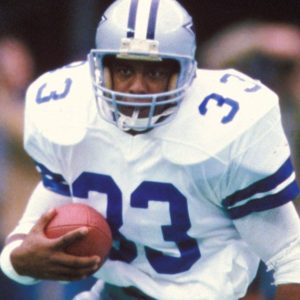 Dallas legend Dorsett falls in the “you had to see him play” category. Sure, he retired ranking behind only Walter Payton in career rushing yards. Yes, his eight season topping one thousand yards was also second only to Payton. [9]It would likely be nine consecutive seasons if not for the strike resulting in a nine-game campaign in 1982. It also seems, from watching the games, that Coach Landry wanted to keep him fresh by … Continue reading But it’s his literally unbreakable record 99 yard touchdown run that is more indicative of his style. You see, Dorsett had blazing speed and was one of the fastest backs ever to carry the ball. Few have ever turned the corner with such alarming quickness. In space, he didn’t have the tantalizing moves of someone like Barry Sanders, but he used subtle movements to bait defenders before hitting a gear no one else could reach and leaving would-be tacklers in the rear view. The Cowboys traded up to draft Dorsett to help their already strong team get over the hump in the postseason. He did his part, earning a Super Bowl victory as a rookie and posting higher yards and touchdowns per game and yard per carry in the postseason than in the regular season.
Dallas legend Dorsett falls in the “you had to see him play” category. Sure, he retired ranking behind only Walter Payton in career rushing yards. Yes, his eight season topping one thousand yards was also second only to Payton. [9]It would likely be nine consecutive seasons if not for the strike resulting in a nine-game campaign in 1982. It also seems, from watching the games, that Coach Landry wanted to keep him fresh by … Continue reading But it’s his literally unbreakable record 99 yard touchdown run that is more indicative of his style. You see, Dorsett had blazing speed and was one of the fastest backs ever to carry the ball. Few have ever turned the corner with such alarming quickness. In space, he didn’t have the tantalizing moves of someone like Barry Sanders, but he used subtle movements to bait defenders before hitting a gear no one else could reach and leaving would-be tacklers in the rear view. The Cowboys traded up to draft Dorsett to help their already strong team get over the hump in the postseason. He did his part, earning a Super Bowl victory as a rookie and posting higher yards and touchdowns per game and yard per carry in the postseason than in the regular season.
Don Maynard (1958-1973)
New York Jets/Titans, New York Giants, St. Louis Cardinals
2 First Team All Pros (AFL), 3 Second Team All Pros (AFL), 4 Pro Bowls, 1 Title Win, 1 GridFe Sweetness Award (AFL), 1 GridFe Bambi Award (AFL)
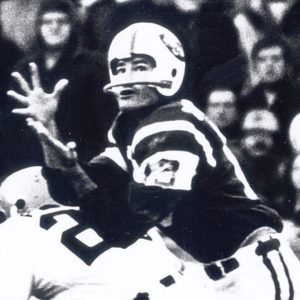 Maynard was the American Football League’s second greatest receiver and the go to downfield weapon for rocket-armed Joe Namath. By the time he retired, he was the career leader in both receptions and receiving yards, and he fell behind only Hutson in touchdown catches. Unlike modern receivers with high reception totals, Maynard was deadly deep threat who averaged 20 yards per catch in four different seasons. His career mark of 18.7 yards per catch rates among the highest in history. Of the receivers with a higher average, only Stanley Morgan (557) and Lance Alworth (542) are within one hundred catches of Maynard’s 633. [10]Only Carroll Dale and Wesley Walker (438 apiece), Paul Warfield (427), and Jimmy Orr (400) even have 400 career catches.
Maynard was the American Football League’s second greatest receiver and the go to downfield weapon for rocket-armed Joe Namath. By the time he retired, he was the career leader in both receptions and receiving yards, and he fell behind only Hutson in touchdown catches. Unlike modern receivers with high reception totals, Maynard was deadly deep threat who averaged 20 yards per catch in four different seasons. His career mark of 18.7 yards per catch rates among the highest in history. Of the receivers with a higher average, only Stanley Morgan (557) and Lance Alworth (542) are within one hundred catches of Maynard’s 633. [10]Only Carroll Dale and Wesley Walker (438 apiece), Paul Warfield (427), and Jimmy Orr (400) even have 400 career catches.
John Mackey (1963-1972)
Baltimore Colts, San Diego Chargers
3 First Team All Pros, 5 Pro Bowls, 1 Title Win, 2 Title Losses, 1 GridFe Gonzo Award
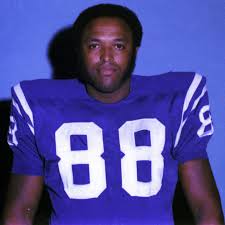 Another player you had to see to truly appreciate, Mackey was a dynamic vertical threat whose brilliance was clear to teammates, opponents, and viewers. In fact, he was named the tight end on the NFL’s 50th anniversary team… while he was still playing! His stats look paltry from modern perspective, but few TEs in history were as dangerous as Mackey – a true deep threat who had the speed to beat defenses over the top and the combination of balance and power to throw defenders to the ground like rag dolls. There has been no better tight end in history when it comes to picking up yards after the catch. In the modern game, it’s common to see a wide receiver serve as a big play threat and a tight end act as a safety blanket for the quarterback. In the Colts offense, Raymond Berry was the possession receiver while Mackey took the top off defenses. If that wasn’t enough, he was also a fierce and eager blocker, often leaving ends in the dirt.
Another player you had to see to truly appreciate, Mackey was a dynamic vertical threat whose brilliance was clear to teammates, opponents, and viewers. In fact, he was named the tight end on the NFL’s 50th anniversary team… while he was still playing! His stats look paltry from modern perspective, but few TEs in history were as dangerous as Mackey – a true deep threat who had the speed to beat defenses over the top and the combination of balance and power to throw defenders to the ground like rag dolls. There has been no better tight end in history when it comes to picking up yards after the catch. In the modern game, it’s common to see a wide receiver serve as a big play threat and a tight end act as a safety blanket for the quarterback. In the Colts offense, Raymond Berry was the possession receiver while Mackey took the top off defenses. If that wasn’t enough, he was also a fierce and eager blocker, often leaving ends in the dirt.
Dave Casper (1974-1984)
Oakland/Los Angeles Raiders, Houston Oilers, Minnesota Vikings
4 First Team All Pros, 5 Pro Bowls, 1 Title Win, 2 GridFe Gonzo Awards
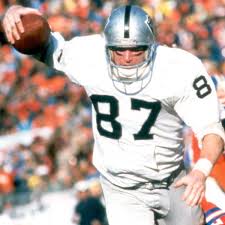 A former All American tackle at Notre Dame, Casper is one of the finest blocking tight ends the game has seen. [11]Among great tights ends who can also catch. Ed West and Hoby Brenner may be the best pure blockers at the position, but they didn’t exactly frighten secondaries with their receiving skill. Similar to Jason Witten, he was an average athlete (by NFL standards) [12]Not by human standards. These guys are all freaks. who excelled as a receiver by finding holes in zones or getting separation against man defenders. Casper was highly successful playing on the eccentric and star-studded cast in Oakland and was involved in some of the most famous plays in NFL history. For a few years, he found similar individual success for a less talented Oilers squad before finally running out of gas.
A former All American tackle at Notre Dame, Casper is one of the finest blocking tight ends the game has seen. [11]Among great tights ends who can also catch. Ed West and Hoby Brenner may be the best pure blockers at the position, but they didn’t exactly frighten secondaries with their receiving skill. Similar to Jason Witten, he was an average athlete (by NFL standards) [12]Not by human standards. These guys are all freaks. who excelled as a receiver by finding holes in zones or getting separation against man defenders. Casper was highly successful playing on the eccentric and star-studded cast in Oakland and was involved in some of the most famous plays in NFL history. For a few years, he found similar individual success for a less talented Oilers squad before finally running out of gas.
Dan Dierdorf (1971-1983)
St. Louis Cardinals
5 First Team All Pros, 1 Second Team All Pro, 6 Pro Bowls, 2 GridFe Guardian Awards
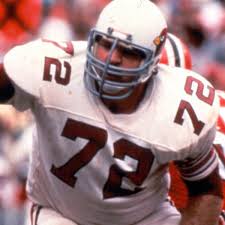 Dierdorf began his career at left tackle before moving to the right side and cementing his legacy as the greatest right tackle in history not named Forrest Gregg. From a modern standpoint, the move from left to right may seem like a demotion. However, in his era, the best tackles tended to play on the right, facing the defense’s best pass rusher. Strong and tough, he bent defenders to his will in the run game and all but eliminated top edge rushers. In fact, he once went over two full seasons without giving up a sack. [13]From the middle of 1975 to the beginning of 1978. While today’s pass protectors play a passive role, giving ground grudgingly, Dierdorf took the attack to opponents quite violently. His ability to neutralize the rush gave valuable time to an aging Jim Hart in Don Coryell’s deep passing offense.
Dierdorf began his career at left tackle before moving to the right side and cementing his legacy as the greatest right tackle in history not named Forrest Gregg. From a modern standpoint, the move from left to right may seem like a demotion. However, in his era, the best tackles tended to play on the right, facing the defense’s best pass rusher. Strong and tough, he bent defenders to his will in the run game and all but eliminated top edge rushers. In fact, he once went over two full seasons without giving up a sack. [13]From the middle of 1975 to the beginning of 1978. While today’s pass protectors play a passive role, giving ground grudgingly, Dierdorf took the attack to opponents quite violently. His ability to neutralize the rush gave valuable time to an aging Jim Hart in Don Coryell’s deep passing offense.
Mick Tingelhoff (1962-1978)
Minnesota Vikings
6 First Team All Pros, 6 Pro Bowls, 4 Title Losses, 6 GridFe Iron Awards
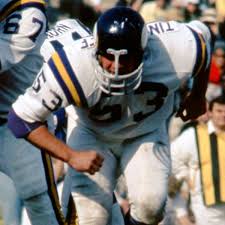 Tingelhoff is a case study for the way postseason failure can shape a player’s legacy. One of the greatest undrafted free agents in history, he was the NFL’s best center for half a decade, a key contributor on several successful teams, an iron man who didn’t miss a start in seventeen years (playing in a remarkable 259 consecutive games), and a quick and masterful technician whose use of leverage and hand placement enable him to take on more powerful defensive tackles. It isn’t easy blocking for a scrambling quarterback, but it’s tough to imagine someone doing a better job protecting the unpredictable Tarkenton as well as Tingelhoff did. However, he is often remembered more for what he didn’t do than what he did. In his first Super Bowl, he had the misfortune of lining up against Curley Culp and Buck Buchanan while having responsibility for Willie Lanier. His shot at Super Bowl redemption saw him square up against the stout No-Name Defense of Miami. The third time around, he faced Joe Greene, Ernie Holmes, and Jack Lambert. His last Super Bowl appearance came when he was 36 years old, in the winter of his career, against a talented Raiders defensive front. [14]In the regular season, his responsibilities included handling division rivals Joe Schmidt, Ray Nitschke, and Dick Butkus. That he was able to face the latter two twice apiece and still win the … Continue reading Tingelhoff came out on the wrong end of those four Super Bowl appearances, and he and his teammates have seen their legacies unjustly diminished because of this.
Tingelhoff is a case study for the way postseason failure can shape a player’s legacy. One of the greatest undrafted free agents in history, he was the NFL’s best center for half a decade, a key contributor on several successful teams, an iron man who didn’t miss a start in seventeen years (playing in a remarkable 259 consecutive games), and a quick and masterful technician whose use of leverage and hand placement enable him to take on more powerful defensive tackles. It isn’t easy blocking for a scrambling quarterback, but it’s tough to imagine someone doing a better job protecting the unpredictable Tarkenton as well as Tingelhoff did. However, he is often remembered more for what he didn’t do than what he did. In his first Super Bowl, he had the misfortune of lining up against Curley Culp and Buck Buchanan while having responsibility for Willie Lanier. His shot at Super Bowl redemption saw him square up against the stout No-Name Defense of Miami. The third time around, he faced Joe Greene, Ernie Holmes, and Jack Lambert. His last Super Bowl appearance came when he was 36 years old, in the winter of his career, against a talented Raiders defensive front. [14]In the regular season, his responsibilities included handling division rivals Joe Schmidt, Ray Nitschke, and Dick Butkus. That he was able to face the latter two twice apiece and still win the … Continue reading Tingelhoff came out on the wrong end of those four Super Bowl appearances, and he and his teammates have seen their legacies unjustly diminished because of this.
References
| ↑1 | The only quarterback who received votes got just two of them. Meanwhile, several linemen just missed the cut. |
|---|---|
| ↑2 | An alternative theory is that we voted for all the worthy offensive players in the inaugural class. Tom Brady, Drew Brees, Aaron Rodgers, Adrian Peterson, Larry Fitzgerald, Jason Witten, and Antonio Gates are still playing. Rob Gronkowski and Joe Thomas were active when we began voting. I suspect with another season to evaluate their careers from a historical perspective, Julio Jones and Antonio Brown will garner more attention. If people are voting for Len Dawson, Philip Rivers and Ben Roethlisberger may also join the discussion. Perhaps Marshal Yanda will receive the recognition from us he deserved from national media. |
| ↑3 | Others receiving votes: Len Dawson, Curtis Martin, Ollie Matson*, Bobby Mitchell*, Elroy Hirsch, Pete Pihos*, Rayfield Wright*, Jim Tyrer*, Gary Zimmerman*, Joe DeLamielleure* |
| ↑4 | The Pro Bowl didn’t exist when Motley played in the AAFC, but he was worthy of the honor all four years. |
| ↑5 | He carried the ball 11 times for 188 yards in a blowout victory over the Steelers in 1950. He lost the record in 2002 when Michael Vick ran 10 times for 173 yards in an electrifying performance against the Vikings. |
| ↑6 | In his nine seasons, he carried the ball 908 times. That isn’t the type of workload you’d expect from a player of his caliber, but much of this is because Paul Brown reportedly tried to limit Motley’s carries to keep him fresh for important games. |
| ↑7 | Like Motley, Perry was worthy of Pro Bowl honors during his time in the AAFC. |
| ↑8 | He managed to hold onto second place for another thirteen years, indicating he didn’t just presage an era and then fail to live up to its standards. |
| ↑9 | It would likely be nine consecutive seasons if not for the strike resulting in a nine-game campaign in 1982. It also seems, from watching the games, that Coach Landry wanted to keep him fresh by limiting his snap counts, even when he played well. It isn’t Dorsett’s fault he didn’t get the volume of some of his contemporaries, but he certainly made the most of every touch. |
| ↑10 | Only Carroll Dale and Wesley Walker (438 apiece), Paul Warfield (427), and Jimmy Orr (400) even have 400 career catches. |
| ↑11 | Among great tights ends who can also catch. Ed West and Hoby Brenner may be the best pure blockers at the position, but they didn’t exactly frighten secondaries with their receiving skill. |
| ↑12 | Not by human standards. These guys are all freaks. |
| ↑13 | From the middle of 1975 to the beginning of 1978. |
| ↑14 | In the regular season, his responsibilities included handling division rivals Joe Schmidt, Ray Nitschke, and Dick Butkus. That he was able to face the latter two twice apiece and still win the NFLPA’s offensive lineman of the year award in 1969 speaks to his brilliant play. |
